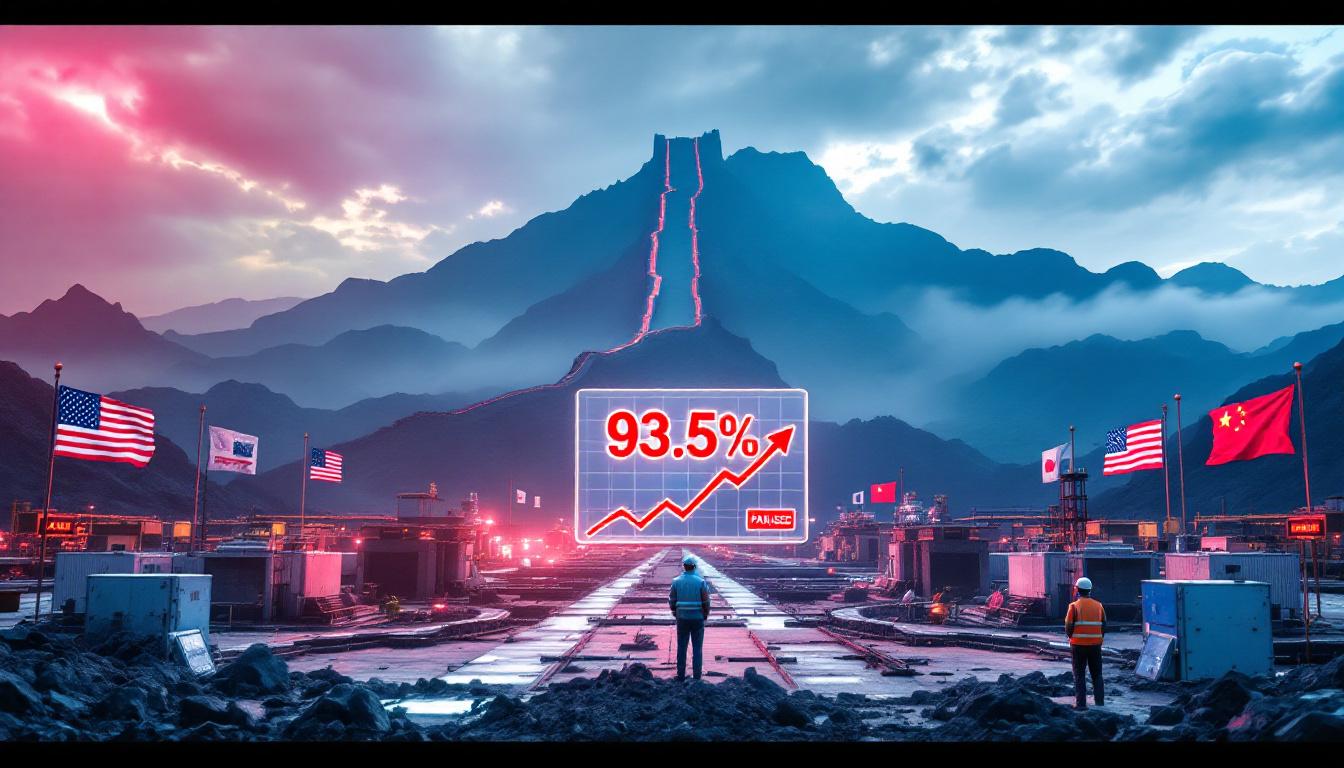Record-Breaking Q1 2025 Performance by MP Materials
MP Materials reached a significant milestone in the first quarter of 2025, with Praseodymium-Neodymium (Pr-Nd) oxide production hitting 563 metric tons—a record high representing a 36% quarter-over-quarter increase. This production surge stems from extensive process optimization and improved operational efficiency at their mining facilities. The company's total rare earth oxide production for Q1 reached an impressive 12,213 metric tons, demonstrating their growing capacity in the rare earth elements market.
According to Shanghai Metal Market (SMM) analysis, MP Materials' achievements were "mainly attributed to process optimization and improved mine operational efficiency," allowing the company to maintain sustained high production rates throughout the quarter.
Key Production Metrics for Q1 2025
- Pr-Nd oxide production: 563 metric tons (36% increase QoQ)
- Total rare earth oxide production: 12,213 metric tons
- REO sold: 6,264 metric tons
- Average selling price: $4,808 per metric ton
- Materials segment revenue: $55.62 million (14% increase YoY)
While these figures represent significant growth, they should be viewed in the context of global production. China, by comparison, produced approximately 90,000 metric tons of Pr-Nd oxide in 2024, according to U.S. Geological Survey data.
Annual Production Context
The company's rare earth oxide production exceeded 45,000 metric tons in 2024, establishing MP Materials as a crucial supplier of raw materials for downstream industries that depend on rare earth elements. This production volume has positioned MP Materials as the largest rare earth producer outside of China, though still representing less than 15% of global production.
MP Materials' Mountain Pass mine in California contains some of the highest-quality rare earth deposits in the world, with ore grades averaging 8% rare earth oxide content—significantly higher than many competing deposits globally, which typically range from 2-4%.
How Is MP Materials Transforming Its Business Strategy?
Shift from Mining to Manufacturing
MP Materials is undergoing a strategic pivot from being primarily an upstream mining operation to becoming an integrated producer of high-value-added rare earth products. This transformation was highlighted by the company's magnetic materials business contributing $5.2 million in revenue for the first time in Q1 2025—a small but significant step in their vertical integration journey.
This strategic shift represents a fundamental business model transformation, moving from selling raw materials to producing finished components that can command premium pricing. While rare earth oxides might sell for thousands per ton, finished NdFeB magnets can command prices exceeding $70,000 per ton.
Supply Chain Localization Efforts
In April 2025, MP Materials announced it would cease exporting rare earth concentrate to China, directly responding to China's implementation of a 125% tariff impact analysis on US imports. This decision represents a dramatic shift for the company, which previously derived approximately 80% of its revenue from concentrate exports to China.
"The tariff made exports to China no longer commercially viable," the company stated in its announcement, necessitating accelerated development of domestic processing capabilities.
This strategic pivot aligns with broader US government initiatives to reduce dependency on Chinese rare earth processing. The Department of Energy provided a $30 million grant to MP Materials in 2023 specifically for its Fort Worth facility development.
Texas Facility Development
MP Materials has invested nearly $1 billion to establish a complete industry chain from mine to magnet production:
- The Texas facility is positioned to become the first fully integrated rare earth magnet production site in the United States
- Current construction focuses on establishing an initial production capacity of 1,000 metric tons of NdFeB magnets annually by 2026
- Advanced automation and proprietary processing technologies are being incorporated to maximize efficiency
- The facility represents a critical component of MP's vertical integration strategy
This investment is particularly significant considering China currently controls approximately 92% of global rare earth magnet production, according to 2024 data from Adamas Intelligence.
What Financial Challenges Does MP Materials Face?
Despite record production levels and revenue growth in Q1 2025, MP Materials reported a widened net loss of $22.6 million, highlighting the financial challenges of their strategic transformation.
This financial performance reflects the complex transition from a relatively straightforward mining operation to a vertically integrated manufacturer requiring significant capital expenditure, advanced technical capabilities, and new market development.
Short-Term Financial Pressures
- Revenue gap from halted rare earth concentrate exports to China, which previously contributed 80% of total revenue
- Downstream separation and magnet production still in investment phase, with limited revenue generation
- Lack of economies of scale in newer operations, increasing per-unit production costs
- Continuous capital expenditure requirements for Texas facility construction
- Development costs for heavy rare earth separation facilities
The company's current financial challenges mirror those faced by other rare earth processors during expansion phases. For example, Lynas Rare Earths experienced similar profitability challenges during its $500 million expansion of Malaysian processing facilities in 2023.
Financial Buffers and Long-Term Outlook
MP Materials maintains approximately $759 million in cash reserves, providing a financial cushion during this transition period. Company management has characterized the current losses as "the inevitable growing pains of re-industrializing the supply chain," emphasizing their long-term goal of improving profitability through vertical integration.
Industry analysts project potential breakeven for the magnetic materials division by late 2026, assuming stable rare earth prices and successful scale-up of the Texas facility to its target capacity.
"Short-term profitability sacrifices are necessary to secure long-term strategic positioning in the rare earth value chain. MP Materials' current investments could yield substantial returns once vertical integration is complete." — CRU Group Rare Earths Analysis, 2024
What Technical Hurdles Is MP Materials Working to Overcome?
Separation Technology Limitations
MP Materials' current separation technology capabilities are limited to light rare earth elements, creating a significant technical challenge. The company still depends on China for the smelting and separation of medium and heavy rare earth elements, which are critical components for many high-tech applications.
This technical limitation has profound implications for MP Materials' vertical integration strategy. While light rare earths (primarily neodymium and praseodymium) are essential for NdFeB magnets, heavy rare earths like dysprosium and terbium are required additives that enhance magnet performance at high temperatures—critical for electric vehicle motors and wind turbine generators.
The hydrometallurgical processes required for heavy rare earth separation are substantially more complex than those for light rare earths, involving hundreds of separation stages with proprietary chemical formulations and precise process controls.
Technological Development Timeline
Achieving breakthroughs in medium and heavy rare earth separation technologies will likely require substantial time and investment. Industry analysts suggest that China's dominant position in the rare earth processing sector is unlikely to be challenged in the short term due to these technical limitations.
According to U.S. Department of Defense data from 2024, China controls approximately 95% of global heavy rare earth production capacity. This concentration creates both a technical and supply chain vulnerability for manufacturers outside China.
MP Materials has filed several patents related to separation technologies through the U.S. Patent and Trademark Office, suggesting active R&D efforts in this area. The company has also established research partnerships with Idaho National Laboratory to accelerate technology development.
How Do Market Conditions Impact MP Materials' Future Prospects?
Price Volatility Concerns
Rare earth element prices have historically been subject to significant fluctuations, which could continue to impact MP Materials' profit margins as they navigate their strategic transformation. The Shanghai Metal Market Annual Report (2024) documented rare earth price fluctuations of approximately 40% in 2023 alone.
For MP Materials, this volatility presents a complex challenge—while higher rare earth prices would increase revenue from oxide sales, they would simultaneously raise input costs for the company's magnetic materials division.
Pr-Nd oxide prices reached approximately $70,000 per metric ton in March 2025, representing a moderate increase from 2024 levels but still below the 2022 peak of over $100,000 per metric ton.
Global Market Position Analysis
While MP Materials is making significant strides in rare earth production, China maintains its position as the dominant global player in rare earth processing and manufacturing. This market dynamic creates both challenges and opportunities for MP Materials as they work to establish a more vertically integrated operation.
According to the U.S. Geological Survey (2024), China controls approximately:
- 60% of global rare earth mining output
- 85% of rare earth processing capacity
- 92% of rare earth magnet production
These figures underscore the scale of China's market dominance and the significant challenge facing MP Materials' diversification efforts.
Strategic Importance in US Supply Chain
MP Materials' efforts align with broader US initiatives to secure domestic supply chains for critical minerals initiatives. The company's development of integrated rare earth processing capabilities represents a strategically important effort to reduce US dependence on foreign sources for these essential materials.
The U.S. Department of Energy has explicitly recognized MP Materials' alignment with national initiatives to secure domestic critical mineral supply chains. This strategic importance has translated into tangible support, including the allocation of $75 million in DOE funding for rare earth projects in 2024, with MP Materials receiving a significant portion.
The Inflation Reduction Act has further strengthened MP Materials' position by providing tax credits for U.S.-made critical minerals, enhancing the economic viability of domestic rare earth production.
What Are the Long-Term Implications of MP's Strategic Shift?
North American Rare Earth Supply Chain Development
MP Materials' investments in vertical integration could potentially catalyze the development of a more robust North American rare earth supply chain, reducing reliance on imports for these critical materials.
According to company presentations, MP Materials aims to supply 15-20% of U.S. rare earth demand by 2030, representing a significant shift in supply chain dynamics. This goal aligns with projected growth in demand from electric vehicles, which require 1-2 kg of rare earth magnets per vehicle according to Adamas Intelligence (2024).
With global EV sales projected to reach 30 million by 2030 (BloombergNEF, 2024), securing domestic supply chains for rare earth magnets represents a strategic imperative for automotive manufacturers.
Industry Competition Dynamics
The company's strategic transformation may encourage other Western companies to invest in rare earth processing capabilities, potentially diversifying global supply chains beyond their current concentration in China.
This trend is already emerging, with companies like Energy Fuels Inc. partnering with Neo Performance Materials to develop U.S. rare earth separation capabilities, as announced in their 2023 press release.
CRU Group's 2024 industry report noted that "Western companies may follow MP's lead in vertical integration," potentially creating a more competitive landscape for rare earth processing outside China.
Technological Innovation Opportunities
MP Materials' challenges in developing separation technologies for medium and heavy rare earths could drive innovation in this space, potentially leading to new processing methods that could benefit the broader industry.
Technological breakthroughs in rare earth separation could have implications beyond magnets, affecting catalysts, polishing compounds, and other applications that rely on specific rare earth elements. Recent patent filings suggest MP Materials is exploring novel solvent extraction techniques that could reduce processing costs and environmental impacts.
FAQ: MP Materials and Rare Earth Production
What are rare earth elements and why are they important?
Rare earth elements comprise 17 metallic elements essential for many high-tech applications including electric vehicles, wind turbines, and defense systems. Despite their name, most rare earths are relatively abundant in the Earth's crust, but economically viable concentrations are less common.
The most commercially significant rare earths include:
- Neodymium and Praseodymium: Critical for high-strength permanent magnets
- Dysprosium and Terbium: Used to enhance magnet performance at high temperatures
- Lanthanum and Cerium: Utilized in catalytic converters and polishing compounds
- Europium and Yttrium: Essential for phosphors in displays and lighting
These elements have unique magnetic, luminescent, and electrochemical properties that make them irreplaceable in many technologies driving the energy transition security.
How does MP Materials' production compare to global rare earth output?
While MP Materials is a significant Western producer of rare earth materials, China still dominates global production with approximately 60% of the world's rare earth mining output and over 85% of processing capacity.
MP Materials' annual production of 45,000 metric tons represents approximately 15% of global rare earth oxide production. However, its contribution to separated rare earth products and finished magnets represents a much smaller percentage of global capacity.
The Mountain Pass mine operated by MP Materials contains some of the world's highest-grade rare earth deposits, with ore averaging 8% rare earth oxide content—significantly higher than typical deposits globally.
What impact could MP Materials' transformation have on rare earth prices?
The development of additional processing capacity outside China could potentially help stabilize rare earth prices by diversifying supply sources, though this effect would likely take several years to materialize as new facilities reach full production capacity.
Historically, rare earth prices have experienced significant volatility, with Pr-Nd oxide prices ranging from $30,000 to over $100,000 per metric ton over the past decade. This volatility has been driven largely by Chinese export policies, which have included quotas, tariffs, and environmental regulations that periodically constrain supply.
MP Materials' vertical integration could provide a more predictable supply source for Western manufacturers, potentially reducing price volatility for specific rare earth products.
How might geopolitical factors affect MP Materials' business strategy?
Increasing trade tensions between the US and China could further accelerate MP Materials' vertical integration efforts, potentially with additional government support for developing domestic rare earth processing capabilities.
The implementation of a 125% tariff by China on U.S. rare earth imports already forced MP Materials to halt concentrate exports to China and accelerate domestic processing development. Future trade measures, including potential U.S. import tariffs on Chinese magnets, could further reshape market dynamics.
The strategic importance of rare earth elements in defense applications—including missile guidance systems, radar, and night vision technology—adds an additional layer of geopolitical significance to MP Materials' development efforts. Furthermore, the ongoing industry transformation trends are pushing companies like MP Materials to adopt more data-driven mining operations to maintain competitiveness.
Disclaimer: This article contains forward-looking statements regarding MP Materials' production capabilities, strategic initiatives, and market positioning. These statements involve risks and uncertainties, and actual results may differ materially from those anticipated. The rare earth market is subject to price volatility, regulatory changes, and geopolitical factors that could impact the company's performance.
Want to Catch the Next Major Mineral Discovery on the ASX?
Discovery Alert's proprietary Discovery IQ model instantly transforms complex discovery announcements into actionable investment insights, just like identifying rare earth opportunities. Explore why historic mineral discoveries can lead to extraordinary market returns by visiting Discovery Alert's dedicated discoveries page and start your 30-day free trial to gain a significant market advantage.




